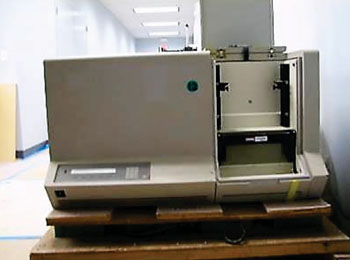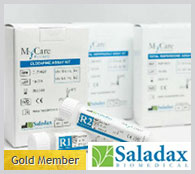Nosocomial Environmental Contamination by MERS-CoV Investigated
|
By LabMedica International staff writers Posted on 04 Jan 2016 |

Image: Applied Biosystems ABI 373 XLDNA sequencer (Photo courtesy of Perkin-Elmer).
Although Middle East Respiratory Syndrome coronavirus (MERS-CoV) is characterized by a risk of nosocomial transmission, the detailed mode of transmission and period of virus shedding from infected patients are poorly understood.
The potential role of environmental contamination by MERS-CoV in health care settings and defining the period of viable virus shedding from MERS patients has been investigated using reverse transcription polymerase chain reaction (PCR), and isolating viable virus by cultures.
Scientists at the Chungbuk National University (Cheongju City, Republic of Korea) and their colleagues enrolled four laboratory-confirmed MERS patients, hospitalized in two hospitals from June 8, 2015, to July 3, 2015. Respiratory specimens and environmental samples were collected and cultured from all patients during the later stages of clinical disease. Viral ribonucleic acid (RNA) was extracted from all samples and MERS-CoV and the RNA amplified and quantified. Amplicons were purified and sequenced on an ABI 373 XLDNA sequencer (Perkin-Elmer; Foster City, CA, USA).
Many environmental surfaces of MERS patient rooms, including points frequently touched by patients or healthcare workers, were contaminated by MERS-CoV. Viral RNA was detected up to five days from environmental surfaces following the last positive PCR from patients' respiratory specimens. MERS-CoV RNA was detected in samples from anterooms, medical devices, and air-ventilating equipment. In addition, MERS-CoV was isolated from environmental objects such as bed sheets, bedrails, intravenous fluid hangers, and X-ray devices. During the late clinical phase of MERS, viable virus could be isolated in three of the four enrolled patients on day 18 to day 25 after symptom onset.
The authors concluded that most of touchable surfaces in MERS units were contaminated by patients and health care workers and the viable virus could shed through respiratory secretion from clinically fully recovered patients. These results emphasize the need for strict environmental surface hygiene practices, and sufficient isolation period based on laboratory results rather than solely on clinical symptoms. The study was published on December 17, 2015, in the journal Clinical Infectious Diseases.
Related Links:
Chungbuk National University
Perkin-Elmer
The potential role of environmental contamination by MERS-CoV in health care settings and defining the period of viable virus shedding from MERS patients has been investigated using reverse transcription polymerase chain reaction (PCR), and isolating viable virus by cultures.
Scientists at the Chungbuk National University (Cheongju City, Republic of Korea) and their colleagues enrolled four laboratory-confirmed MERS patients, hospitalized in two hospitals from June 8, 2015, to July 3, 2015. Respiratory specimens and environmental samples were collected and cultured from all patients during the later stages of clinical disease. Viral ribonucleic acid (RNA) was extracted from all samples and MERS-CoV and the RNA amplified and quantified. Amplicons were purified and sequenced on an ABI 373 XLDNA sequencer (Perkin-Elmer; Foster City, CA, USA).
Many environmental surfaces of MERS patient rooms, including points frequently touched by patients or healthcare workers, were contaminated by MERS-CoV. Viral RNA was detected up to five days from environmental surfaces following the last positive PCR from patients' respiratory specimens. MERS-CoV RNA was detected in samples from anterooms, medical devices, and air-ventilating equipment. In addition, MERS-CoV was isolated from environmental objects such as bed sheets, bedrails, intravenous fluid hangers, and X-ray devices. During the late clinical phase of MERS, viable virus could be isolated in three of the four enrolled patients on day 18 to day 25 after symptom onset.
The authors concluded that most of touchable surfaces in MERS units were contaminated by patients and health care workers and the viable virus could shed through respiratory secretion from clinically fully recovered patients. These results emphasize the need for strict environmental surface hygiene practices, and sufficient isolation period based on laboratory results rather than solely on clinical symptoms. The study was published on December 17, 2015, in the journal Clinical Infectious Diseases.
Related Links:
Chungbuk National University
Perkin-Elmer
Latest Molecular Diagnostics News
- Respiratory Panel to Help Clinicians Make Precise Treatment Decisions in Outpatient Settings
- Integrating Cardiovascular Risk Biomarkers Aids in Detection of ‘Inflammaging’
- Genetic Signature in Newborns Predicts Neonatal Sepsis Before Symptoms Appear
- Integrating Multiple Protein Markers Predicts Health Outcomes in Chronic Kidney Disease Patients
- Rapid Finger Prick Blood Test to Detect Active Syphilis at Point of Care
- Urine Tests Could Reveal Early Signs of Cancer and Other Diseases
- AI-Powered Smart PCR System to Revolutionize Clinical Diagnostics
- Simple Blood Test Identifies Women in Labor at Risk for Preeclampsia
- Point-Of-Care Paper-Based Test Could Diagnose Cancer at Bedside
- Sepsis Test Demonstrates Clinical Utility in Critically Ill Heterogeneous Patient Populations
- Multi-Cancer Early Detection Test Measures Host Response to Tumor Development
- MicroRNA-Based Test Identifies 12 Cancers Simultaneously Across Any Stage
- New Blood Test Platform Simultaneously Measures Over 100 Biomarkers of Alzheimer's Disease

- First-Ever Blood Test Diagnoses Maternal Autoantibody Related Autism
- Precision Medicine Blood Test Predicts Heart Disease Before It Occurs
- Blood-Based PCR Test Guides Alzheimer's Therapy
Channels
Clinical Chemistry
view channel.jpg)
POC Saliva Testing Device Predicts Heart Failure in 15 Minutes
Heart failure is a serious condition where the heart muscle is unable to pump sufficient oxygen-rich blood throughout the body. It ranks as a major cause of death globally and is particularly fatal for... Read more
Screening Tool Detects Multiple Health Conditions from Single Blood Drop
Infrared spectroscopy, a method using infrared light to study the molecular composition of substances, has been a foundational tool in chemistry for decades, functioning similarly to a molecular fingerprinting... Read more
Integrated Chemistry and Immunoassay Analyzer with Extensive Assay Menu Offers Flexibility, Scalability and Data Commutability
As global healthcare systems increasingly shift towards networked laboratory operational models to enhance efficiency and patient access, there is a greater need for innovative solutions tailored to the... Read moreMolecular Diagnostics
view channel
Respiratory Panel to Help Clinicians Make Precise Treatment Decisions in Outpatient Settings
Respiratory tract infections are the primary reason for visits to emergency departments and subsequent hospitalizations. In the U.S., it is estimated that there are up to 41 million cases of influenza... Read more
Integrating Cardiovascular Risk Biomarkers Aids in Detection of ‘Inflammaging’
Cardiovascular diseases (CVD) continue to be the leading cause of death globally, responsible for nearly one-third of all fatalities worldwide. Traditionally, risk assessment for CVD has focused on well-established... Read more
Genetic Signature in Newborns Predicts Neonatal Sepsis Before Symptoms Appear
Neonatal sepsis, which occurs due to the body’s abnormal response to severe infection within the first 28 days of life, results in approximately 200,000 deaths globally each year. This condition affects around 1.... Read more.jpeg)
Integrating Multiple Protein Markers Predicts Health Outcomes in Chronic Kidney Disease Patients
Previous attempts to discover novel kidney biomarkers as risk factors for chronic kidney disease (CKD) progression have generally focused on evaluating proteins individually, which limits their prognostic... Read moreHematology
view channel
Next Gen CBC and Sepsis Diagnostic System Targets Faster, Earlier, Easier Results
Every hour is critical in protecting patients from infections, yet there are currently limited tools to assist in early diagnosis before patients reach a hospital. The complete blood count (CBC) is a common... Read more
Newly Discovered Blood Group System to Help Identify and Treat Rare Patients
The AnWj blood group antigen, a surface marker discovered in 1972, has remained a mystery regarding its genetic origin—until now. The most common cause of being AnWj-negative is linked to hematological... Read more
Blood Platelet Score Detects Previously Unmeasured Risk of Heart Attack and Stroke
Platelets, which are cell fragments circulating in the blood, play a critical role in clot formation to stop bleeding. However, in some individuals, platelets can become "hyperreactive," leading to excessive... Read moreImmunology
view channel
Computational Tool Predicts Immunotherapy Outcomes for Metastatic Breast Cancer Patients
Immunotherapy aims to enhance the body’s immune response to target cancer cells, but not all patients experience a positive reaction to such treatments. Identifying which patients will benefit from immunotherapy... Read more
Biomarker Could Predict Immunotherapy Response in Liver Cancer
Until recently, patients diagnosed with hepatocellular carcinoma had limited treatment options, with existing therapies extending life by only a few months. Immunotherapy has emerged as a new alternative... Read more
Epigenetic Test Could Determine Efficacy of New Immunotherapy Treatments Against Multiple Myeloma
Multiple myeloma is a blood cancer that primarily affects individuals over the age of sixty, and its occurrence rises as the population ages. In this disease, the bone marrow—the spongy tissue inside bones... Read morePathology
view channel
New Imaging Method Opens Door to Precision Diagnostics for Head and Neck Cancers
Head and neck cancers, while considered rare, represent a significant portion of cancer cases and have seen a notable increase over the past 30 years. These cancers encompass various malignant tumors that... Read more
Faster Measurement of Vibrational Fingerprint of Molecules to Advance Biomedical Diagnostics
Identifying different types of molecules and cells is a vital process in both basic and applied science. Raman spectroscopy serves as a widely utilized measurement technique for this purpose.... Read moreTechnology
view channel
New Noninvasive Methods Detect Lead Exposure Faster, Easier and More Accurately at POC
Exposure to lead can negatively affect health in multiple ways, leading to damage in the brain and central nervous system, delays in development and growth, learning and behavioral issues, problems with... Read more
Noninvasive Test Detects Malaria Without Blood Sample
Malaria remains a significant global health issue, with approximately 250 million cases and over 600,000 deaths reported annually. Nearly half of the world's population is at risk for malaria infection,... Read moreIndustry
view channel
Beckman Coulter Partners with BioPorto for Global Distribution of Acute Kidney Injury NGAL Tests
Acute kidney injury (AKI) is a sudden episode of kidney failure or damage that can occur within a few hours or days. This condition leads to the accumulation of waste products in the blood and disrupts... Read more_1.jpg)
CACLP 2025 New Date and Venue Announced
The 22nd China International In Vitro Diagnostic Expo, organized by the China Association of Clinical Laboratory Practice Expo (CACLP, Shanghai, China), is set to take place from March 21 to 24, 2025,... Read more
Roche to Develop New Diagnostic Technologies for Traumatic Brain Injuries
Traumatic brain injuries (TBI) represent a significant global health issue, affecting approximately 69 million people each year. TBI occurs when an external force disrupts normal brain function, with severity... Read more







.jpg)








